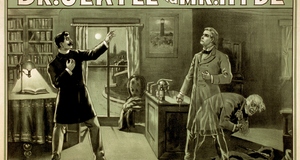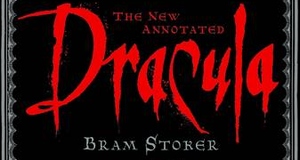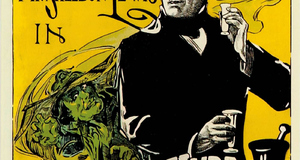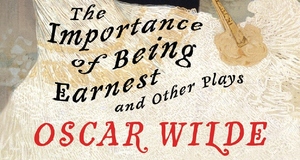Exploring the Corruption of the Soul in the Works of Oscar Wilde, Bram Stoker, and Robert Louis Stevenson
By
2015, Vol. 7 No. 04 | pg. 1/2 | »
KEYWORDS:
Oscar Wilde’s The Picture of Dorian Gray, Bram Stoker’s Dracula, and Robert Louis Stevenson’s Strange Case of Dr. Jekyll and Mr. Hyde are all "Democratic Age"1 novels that evoke a theme of appearance versus reality. In Wilde’s The Picture of Dorian Gray, this motif physically materializes in the form of the canvas of Dorian Gray, superficially a beautiful, charming and wealthy young man. Similarly, a physical depiction of this theme is shown via the vehicle of Count Dracula, an alluring vampire with a corrupting influence, and his interactions with other characters. By the same token, Stevenson’s Strange Case of Dr. Jekyll and Mr. Hyde elucidates the dichotomy between looks and actuality through dual personalities, Dr. Jekyll and Mr. Hyde. This theme of appearance versus reality manifests itself in the nuances of each work and provides an avenues to explore ideas of corruption in society. In Oscar Wilde’s The Picture of Dorian Gray, the canvas of Dorian Gray provides a physical manifestation of the reality of his moral degradation. Initially, just as Dorian begins to commit terrible deeds such as treating Sibyl Vane, his lover, cruelly, the painting undergoes a slow transformation: “Finally, he came back, went over to the picture, and examined it…The expression looked different. One would have said that there was a touch of cruelty in the mouth…The quivering ardent sunlight showed him the lines of cruelty round the mouth as clearly as if he had been looking into a mirror after he had done some dreadful thing” (Wilde Ch. 7). The canvas reflects his horrible exploits: as Dorian’s purity is sullied by evil actions, the canvas deteriorates. The painting, in essence, absorbs his sins, thereby becoming tarnished. This discrepancy between Dorian Gray’s impeccable, youthful, handsome appearance and his actual monstrous interior raises the theme of appearance versus reality.In addition, the juxtaposition between Dorian and his self-portrait provides a vehicle through which the reader can understand corruption in society. When Dorian first recognizes that his wish to remain youthful has been realized, the reader notices, after suspension of disbelief of the supernatural, that Dorian is actually more corrupt than, prima facie, evident. Though Dorian appears to be devoid of physical signs of evil, his portrait becomes increasingly sinister with every crime he commits, as he notes, “It was perfectly true. The portrait had altered” (Wilde Ch. 8). In essence, the canvas physically represents his conscience and appears to bear the brunt of his immoral behavior. Wilde even explicitly states that this canvas is a “visible symbol of the degradation of sin” (Wilde Ch. 8) and “an ever-present sign of the ruin men brought upon their souls” (Wilde Ch. 8). In so doing, he says that the painting is directly linked to both the corruption of Dorian’s soul and moral degradation of man in general. Thus, Wilde manages to incorporate superficial appearance and reality into his work through physical manifestation in order to elucidate how individuals in society can mask their sins and desires. Wilde continues to juxtapose Dorian’s appearance to the physical condition of the canvas in order to emphasize how corruption can be hidden – in the form of a canvas in an attic – in society. For example, after Dorian squanders twenty years destroying people’s lives, his canvas depicts “hideous lines” (Wilde Ch. 11) across a “wrinkling forehead or crawled around the heavy sensual mouth” (Wilde Ch. 11). Wilde also notes the contrast between Dorian’s “white hands” (Wilde Ch. 11) and the “coarse bloated hands of the picture” (Wilde Ch. 11). This blatant distinction between appearance and reality serve to explore the concept of corruption, as corruption seems to solely manifest itself in the canvas, which physically represents actuality, rather than Dorian himself. Thus, this theme allows the reader to explore the embodiment of corruption, typically hidden below the surface, within society. Oscar Wilde continues to examine looks and actuality, particularly when he illustrates how readily outer beauty is associated with goodness. Dorian’s appearance immediately causes individuals to question the widely circulating reports of his wicked behavior, given the incongruity between those deeds and Dorian’s innocent appearance. Characters such as Basil Howard, an old friend of Dorian Gray, view Dorian’s youthful and naive countenance as an accurate reflection of his worth and character. For example, Basil remarks, “‘sin is a thing that writes itself across a man's face. It cannot be concealed’” (Wilde Ch. 12), thereby implying that Dorian would never be capable of such sin, given his virtuous appearance. However, he, among others, fails to look beyond the surface and see Dorian Gray for what he truly has become: a monster. Accordingly, Wilde raises this theme so as to reveal how Dorian’s corruption is not always physically evident and, interestingly, can be masked by appearance. In Bram Stoker’s Dracula, the title character is depicted as polite and courteous, especially upon the arrival of his lawyer, Mr. Harker, to his home. Dracula warmly greets Mr. Harker, as the former states, “‘I bid you welcome, Mr. Harker, to my house. Come in; the night air is chill, and you must need to eat and rest’” (Stoker Ch. 2). Dracula reacts to Harker’s arrival with human-like qualities such as sympathy and concern. The count appears to be a hospitable man with good intentions, but later on, the reality of his intent manifests itself, as Dracula actually aims to keep Harker prisoner in his castle. Harker serves as a vehicle through which the reader can understand Dracula’s true nature. For example, upon exploring Dracula’s castle, Harker notes, “I explored further; doors, doors, doors everywhere, and all locked and bolted. In no place save from the windows in the castle walls is there an available exit. The castle is a veritable prison, and I am a prisoner!” (Stoker, Ch. 2). As evidenced by this statement, Dracula goes to extreme measures to confine Harker, thereby evincing his true evil nature. The discrepancy between appearance and truth is continually elucidated, as Harker discovers that he cannot see Dracula when he looks in the mirror: “This time there could be no error, for the man was close to me, and I could see him over my shoulder. But there was no reflection of him in the mirror! The whole room behind me was displayed; but there was no sign of a man in it, except myself” (Stoker Ch. 2). The mirror conveys reality in the sense that Dracula is a supernatural creature and not a human being. Although the mirror reflects the truth, however, Dracula’s personal appearance is masked by his civility, as demonstrated by his “good-morning” (Stoker Ch. 2) salutation and his “courtly bow” (Stoker Ch. 2) towards Harker the previous day. Moreover, Dracula’s vampire-like qualities are hidden by his deceptively courteous behavior. This juxtaposition between that which is real versus feigned allows the reader to explore how corruption, typically hidden, can manifest itself in society. Upon accidentally cutting himself with his razor, Harker’s notion that something about Dracula inspires a strange uneasiness is only reinforced: “but at the instant I saw that the cut had bled a little, and the blood was trickling over my chin…When the Count saw my face, his eyes blazed with a sort of demoniac fury, and he suddenly made a grab at my throat” (Stoker Ch. 2). Dracula’s eyes reveal his intentions, as his thirst for Harker’s blood becomes blatantly obvious. Dracula’s vampirism is exposed through his aggressive lust for Harker’s bodily fluid; accordingly, this scene evokes the theme of appearance versus reality, as Dracula’s initially deferential greetings morph into violent and corrupt deeds. Thus, Stoker aptly illustrates how not only corruption can lurk beneath the surface but also how looks can belie truth. Dracula further reveals his malevolent plans for Harker, as he objectifies Harker and plans to eventually dispose of him. Dracula even promises his mistress vampires that he will hand over Harker to them: “Well, now I promise you that when I am done with him you shall kiss him at your will” (Stoker, Ch. 3). Dracula essentially avers that his mistress vampires can do as they please with Harker once the latter is no longer of any use to him. As the Count cruelly plans to dispose of Harker, he is thereby depicted as a callous and cold-blooded figure. This characterization only further magnifies the incongruity between Dracula’s earlier façade and his true nature. By the same token, Dracula’s discloses his depraved character when he manipulates Harker into remaining prisoner. Dracula aims to accomplish his goal by threatening Harker with vicious, hungry wolves, in reaction to which Harker soon responds, “I was to be given to the wolves, and at my own instigation. There was a diabolical wickedness in the idea great enough for the count, and as a last chance I cried out:—‘Shut the door; I shall wait till morning!’” (Stoker Ch. 4). As evidenced by this statement, Dracula cleverly places a physical obstacle before Harker, thereby causing Harker to temporarily surrender his fight for freedom – ultimately, the prospect of death looming over his head simply outweighs the prisoner’s desire to escape. Dracula’s overtly cruel deed qualifies him as a malevolent creature who, contrary to what his initial polite behavior might suggest, is very sinister. Moreover, this contrast between appearance and reality physically is conveyed in the form of Dracula, as he feigns politeness, thereby appearing considerate, whereas, in reality, he is a cruel, corruptible individual. Furthermore, though Dracula ostensibly exudes kindness and moral decency, he, on the contrary, proves to be a destructive and noxious influence, particularly on Lucy Westenra, a youthful, innocent and pure woman. When Dracula drinks Lucy’s blood and turns her into a vampire, he demonstrates his corrupting effect on her: “Her breathing grew stertorous, the mouth opened, and the pale gums, drawn back, made the teeth look longer and sharper than ever…she opened her eyes, which were now dull and hard at once, and said in a soft, voluptuous voice, such as I had never heard from her lips:—“Arthur! Oh, my love, I am so glad you have come! Kiss me!” (Stoker Ch. 12). Dracula causes Lucy to undergo a drastic behavioral transformation from pure to promiscuous. Lucy becomes less and less human-like, as evidenced by the “canines,” owing to Dracula’s actions. Dracula corrupts Lucy by robbing her of her humanity and ultimately catalyzes her demise, as he continues to drain Lucy of her blood, evidenced by the “horribly white and mangled” “two little wounds” on her bare throat (Stoker Ch. 12). In essence, Dracula is responsible for her deteriorating condition. Moreover, Stoker contrasts Dracula’s appearance with his intentions in order to explore the corruptibility of individuals and how facades can beguile people and disguise true motives.Continued on Next Page » Suggested Reading from Inquiries Journal
Inquiries Journal provides undergraduate and graduate students around the world a platform for the wide dissemination of academic work over a range of core disciplines. Representing the work of students from hundreds of institutions around the globe, Inquiries Journal's large database of academic articles is completely free. Learn more | Blog | Submit Latest in Literature |


















